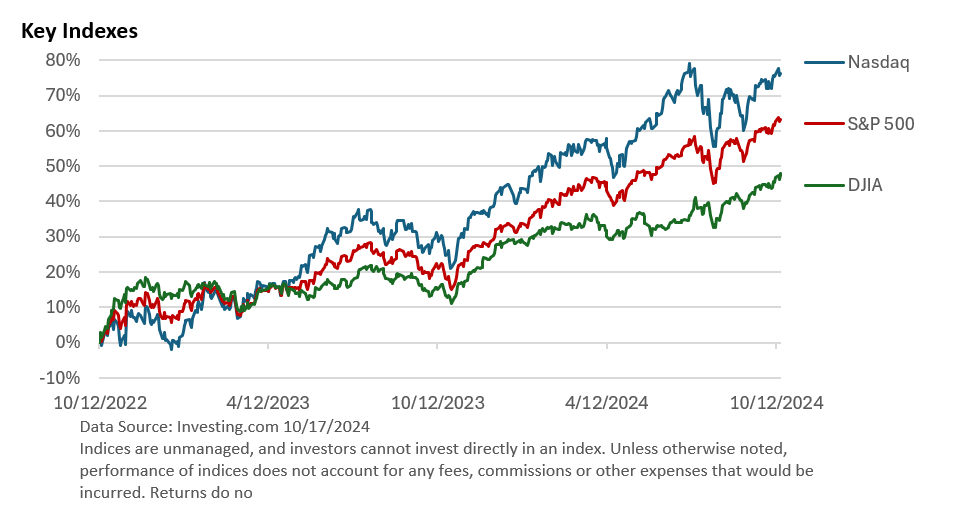The Week in Review: October 21, 2024
Happy Birthday
We love Birthdays and SCM! Last week, the bull market turned two years old. Since bottoming, the S&P 500 Index has climbed almost 64% (through 10/17/24). According to data from the St. Louis Federal Reserve, the index is up 22% from its early 2022 peak. Following the 2022 peak, the S&P 500 entered a nine-month bear market, shedding 25%.
But not all indexes are created equally. The Nasdaq takes top honors, as shown in the illustration above. The Nasdaq Composite is weighted toward technology firms, and the AI revolution has helped fuel outsized gains.
The S&P 500 Index takes second place. It is what’s called a market-capitalization-weighted index, which means the largest companies have an outsized influence over the index.
Since the start of the new bull market, the largest companies in the index have, on average, outperformed the smaller firms, contributing to the overall performance.
According to S&P Global, the top 10 stocks in the S&P 500 would be up about 100% over the last two years. They account for over 30% of the entire S&P 500 Index, according to Slickcharts.
The Dow Jones Industrial Average utilizes a different method. Still, it’s up a respectable 48%. Like the S&P 500, it has repeatedly set new highs this year. Sources: U.S. Treasury, MarketWatch
While the rally has been concentrated in the larger companies, a measure that equally weights all S&P 500 companies has advanced a still-solid 42%, according to S&P Global.
Forces driving the bull market
The answer to the question is pretty simple: it’s the economic fundamentals.
While prices for goods and services are high, the rate of price hikes has slowed, which allowed the Federal Reserve to reduce the pace of rate hikes in late 2022 and into 2023.
Investors aren’t as concerned about price levels. Instead, they focus on the rate of change, which has moderated significantly.
Eventually, the fed funds rate plateaued, and the Fed finally announced a rate cut last month. Moreover, the economy is still growing, which is supporting the growth of corporate profits.
In other words, the combination of stable/decreasing interest rates and profit growth is helping stocks.
Bear markets
Bear markets, defined as a 20% or greater decline in the S&P 500, have historically been associated with recessions.
According to St. Louis Federal Reserve data, only two bear markets have deviated from this historical pattern since the mid-1960s.
First, there was the one-day market crash of 1987, which was driven by computer program trading, and second, there was the bear market of 2022, which can be traced to the Fed’s aggressive series of rate hikes.
As we enter the last two months of the year, any number of factors could create unwanted volatility in the market. We know from experience that market pullbacks can occur at any time and when they are least expected.
Yet, the factors supporting stocks over the past year are still relevant.
Market Summary
Two for the Road
The vacancy rate in American offices has reached 20.1%, the highest since the rating agency began tracking it in 1979. - Moody’s, September 10, 2024
An average NFL broadcast lasts well over three hours, yet it delivers a total of only 18 minutes of football action. - FiveThirtyEight, January 31, 2020
Please do not hesitate to contact me with any questions or concerns. I hope you have a wonderful week!
Bill Stordahl, CFP®
Managing Director
Stordahl Capital Management
Stordahl Capital Management, Inc is a Registered Investment Adviser. This commentary is solely for informational purposes and reflects the personal opinions, viewpoints, and analyses of Stordahl Capital Management, Inc. and should not be regarded as a description of advisory services or performance returns of any SCM Clients. The views reflected in the commentary are subject to change at any time without notice. Nothing in this piece constitutes investment advice, performance data or any recommendation that any particular security, portfolio of securities, transaction or investment strategy is suitable for any specific person. Any mention of a particular security and related performance data is not a recommendation to buy or sell that security. Advisory services are only offered to clients or prospective clients where Stordahl Capital Management and its representatives are properly licensed or exempt from licensure. No advice may be rendered by Stordahl Capital Management unless a client service agreement is in place. Stordahl Capital Management, Inc provides links for your convenience to websites produced by other providers or industry-related material. Accessing websites through links directs you away from our website. Stordahl Capital Management is not responsible for errors or omissions in the material on third-party websites and does not necessarily approve of or endorse the information provided. Users who gain access to third-party websites may be subject to the copyright and other restrictions on use imposed by those providers and assume responsibility and risk from the use of those websites. Please note that trading instructions through email, fax, or voicemail will not be taken. Your identity and timely retrieval of instructions cannot be guaranteed. Stordahl Capital Management, Inc. manages its clients’ accounts using a variety of investment techniques and strategies, which are not necessarily discussed in the commentary. Investments in securities involve the risk of loss. Past performance is no guarantee of future results.
1. The Dow Jones Industrials Average is an unmanaged index of 30 major companies which cannot be invested into directly. Past performance does not guarantee future results.
2. The NASDAQ Composite is an unmanaged index of companies which cannot be invested into directly. Past performance does not guarantee future results.
3. The S&P 500 Index is an unmanaged index of 500 larger companies which cannot be invested into directly. Past performance does not guarantee future results.
4. The Global Dow is an unmanaged index composed of stocks of 150 top companies. It cannot be invested into directly. Past performance does not guarantee future results.
5. CME Group front-month contract; Prices can and do vary; past performance does not guarantee future results.
6. CME Group continuous contract; Prices can and do vary; past performance does not guarantee future results.


